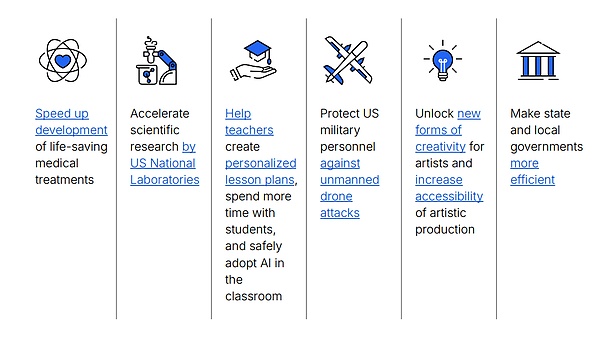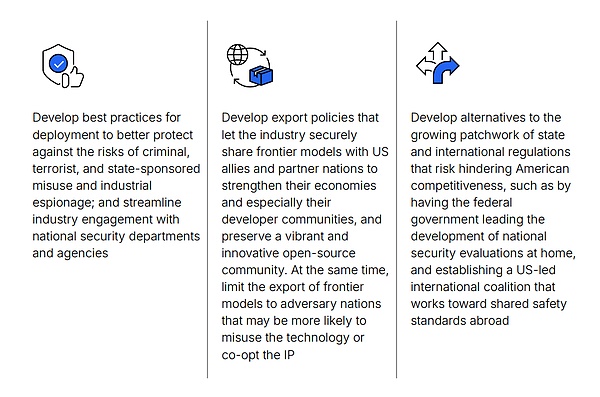Source: Newin
On the evening of January 13, OpenAI officially released a 16-page "OpenAI’s Economic Blueprint" economic blueprint report, which describes how the United States can maximize the advantages of AI, strengthen national security, and promote economic growth.

OpenAI Vice President Chris Lehane wrote that OpenAI is a company dedicated to making artificial intelligence (AI) benefit everyone. Their mission is to enable AI to benefit humanity to the greatest extent by helping to solve complex problems. These problems include improving medical standards and education quality, accelerating scientific discovery, improving public policies and services, and improving production efficiency.

Currently, OpenAI's tools have been used by more than 300 million people around the world and have helped 3 million developers create, discover and innovate. These tools are used in the following areas:
• Accelerate the development of life-saving medical treatments;
• Promote scientific research conducted by US national laboratories;
• Help teachers create personalized lesson plans, engage more with students and safely introduce AI into the classroom;
• Protect the US military from drone attacks;
• Unlock new forms of creativity and increase accessibility to artistic creation;
• Improve the efficiency of state and local governments;
OpenAI emphasizes that the United States needs to act now to maximize the potential of AI while minimizing its harm. AI is an extremely powerful technology that cannot be controlled by dictators. At the same time, the economic opportunities brought by AI cannot be missed. By building the necessary infrastructure, the new jobs and growth that AI can bring are just around the corner.
As CEO Sam Altman writes, AI will help future generations do many things that we can't do today. The future is not far away, and a time when everyone lives better than today is coming.
To achieve shared prosperity, OpenAI hopes to work with policymakers to ensure that the benefits of AI are shared responsibly and fairly. They also emphasized that entrepreneurship and personal freedom are at the core of the American innovation ecosystem.
Among them, OpenAI put forward a view on how the economic potential of AI technology can promote the reindustrialization of the United States. Chris Lehane emphasized that if AI developers and companies can properly respond to the current technological opportunities, the broad economic benefits brought by AI will help the United States achieve economic reindustrialization.
Historically, the United States has played a key role in major technological changes many times. Chris Lehane Gives the example of the rise of the automobile industry: Although the automobile was not invented in the United States, the United States has unlocked the potential of this new technology through public-private partnerships, achieving comprehensive benefits from economic to national security. The United Kingdom, on the other hand, restricted industry development with the Red Flag Act of 1865, which required people to walk in front of cars with flags and limited cars to speeds of no more than 4 mph.
The United States took a very different approach, blending the innovative vision of the private sector with the foresight of the public sector, ultimately making it the center of the world's automobile industry. Mass production of affordable cars and the construction of a nationwide highway system not only solved public safety issues, but also unlocked industrial potential.
OpenAI presents a view on how the economic potential of AI technology can drive the reindustrialization of the United States. Chris Lehane also emphasizes that if AI developers and companies can properly respond to the current technological opportunities, the broad economic benefits brought by AI will help the United States achieve economic reindustrialization.
Historically, the United States has played a key role in major technological changes many times. The rise of the automobile industry is illustrated by the example that, although the automobile was not invented in the United States, the United States has stimulated the potential of this new technology through public-private partnerships, achieving comprehensive benefits from the economy to national security. The United Kingdom, on the other hand, restricted industry development due to the Red Flag Act of 1865 (requiring people to walk in front of cars with flags and limiting cars to speeds of no more than 4 mph).

The United States' approach was completely different, blending the innovative vision of the private sector with the foresight of the public sector, ultimately making it the center of the world's automobile industry. Mass production of affordable cars and the construction of a nationwide highway system have both solved public safety issues and unleashed industrial potential.
Chris Lehane also mentioned that OpenAI will be committed to working with American policymakers to explore how AI can better serve national and public interests. They are committed to democratic values and are committed to promoting AI technology based on these values around the world.
OpenAI also believes that America’s support for innovation is key to its success. That’s why OpenAI’s CEO will kick off this effort at a conference in Washington, D.C. on January 30.
The conference will showcase the state of AI and its potential to drive economic growth. The event will also launch Innovate America, an initiative to work with states across the country to ensure the economic benefits of AI reach Americans in all walks of life.
Where We Stand
In the “Where We Stand” section, OpenAI lays out the core points of its policy advocacy, which make the following points clear:
• We believe in America because America believes in innovation. Innovation is the core driver of America’s continued growth.
• Chips, data, energy, and talent are the keys to winning the AI race. This is a race America must win.
• There is $175 billion in funding waiting to be invested in AI projects around the world. If the United States cannot attract this funding, it will flow to projects backed by China, thereby strengthening China’s influence around the world.
• The rules for the development and use of AI should be based on the democratic values that the United States has always advocated, which OpenAI calls “democratic AI.”
• As with any industry, sensible rules are needed to protect the public safety while helping innovators thrive by encouraging investment, competition, and greater freedom. To better achieve this goal, these rules should apply nationwide.
This section reaffirms OpenAI’s confidence in AI technology and their determination to promote the development of AI in a democratic and responsible manner, while highlighting the United States’ important position and strategic advantage in the global AI competition.
Competitiveness and Security
In the “Competitiveness and Security” section, OpenAI articulates important measures to ensure that AI benefits the most people, namely, protecting the public from real harms through sensible rules and building AI on the basis of democratic values. These values include:

Free market: Promote free and fair competition to promote innovation.
Freedom of developers and users: They can use and guide AI tools according to their own needs, but they must abide by reasonable and clear standards to ensure that AI is safe for everyone. At the same time, when the rules are broken, they should be held accountable.
Prevent government abuse of AI tools: Avoid accumulating power through AI tools to control its citizens, or threaten or coerce other countries.
The federal government should clear the way for the development of the AI industry, just as it helped the automotive industry clear obstacles, including resolving the complexity of different rules between states, so as to ensure that the development of AI frontier models can promote the economic and national security of the United States.
"Frontier models" refers to large language models that are at the forefront of capability benchmarks. OpenAI emphasizes that these models should be exported responsibly to allies and partners to help them build their own AI ecosystems, including innovation in the developer community and the distribution of AI benefits, while ensuring that these technologies are built on American technology rather than Chinese funding.
OpenAI also discussed strategic recommendations for ensuring the security of cutting-edge models and national competitiveness, emphasizing the importance of the federal government in developing policies and providing support. The following are key points of the strategy:
1) Prioritize national competitiveness and national security
Led by the federal government and in partnership with industry, this strategy should include:
Develop best practices: protect deployment from the risk of criminal, terrorist and state-sponsored abuse and industrial espionage, while simplifying industry cooperation with national security departments and agencies.
Develop export policies: ensure that industry can safely share cutting-edge models with U.S. allies and partner countries, support their economies and developer communities, and protect open innovation ecosystems; while limiting exports to adversary countries that may abuse technology.
Establishing Alternative Regulatory Frameworks: To reduce the risk to U.S. competitiveness caused by differences in state and international rules, the federal government should take the lead in establishing national security assessments and lead international cooperation to achieve shared security standards.
2) OpenAI’s Current Actions
OpenAI has taken actions to support this strategy, including:
Developing an industry-leading “Preparedness Framework” to test cutting-edge models for national security risks (such as assessing their ability to create new cyber threats).
Mitigating risks through customized safeguards.
Supporting the adoption of its models by allies and partner nations, and working with partners such as national laboratories and defense research agencies.
3) Federal Government Support Recommendations
To help U.S. AI companies safely develop and deploy cutting-edge models, the federal government should:
Share national security information: such as briefings on security threats and model testing results.
Incentivize AI companies to deploy their products widely: including supporting allies, partner nations, and U.S. government agencies.
Support the development of standards and safeguards: ensure they are internationally recognized and accepted, and promote direct collaboration with government agencies.
Help companies obtain secure infrastructure: such as classified computing clusters for assessing the security risks of models.
Promote transparency: promote transparency consistent with market competition while protecting trade secrets.
Create a voluntary collaboration pathway: work with companies developing large language models to define model evaluation, test models, and exchange information.
4) Recommendations for Further Coordination with the Government
AI builders can strengthen their collaboration with the federal government by:
Forming coalitions to identify best practices related to national security.
Developing training programs to foster the next generation of AI talent, especially in regions that have not fully participated in past waves of innovation.
This section emphasizes the importance of collaboration while proposing specific actions to promote U.S. security and leadership in the AI race.
“Rules of the Road”
This section discusses the importance of developing “Rules of the Road” that emphasize clear, predictable rules to ensure the safe use and widespread deployment of AI while unleashing its full potential.
American-led AI Development
Wide Deployment of AI Technologies: Promote public trust in AI by ensuring its safe use.
Democratic values: Support free markets and allow AI developers and users to work and collaborate responsibly.
Moving toward the Intelligence Age: AI is viewed as an infrastructure technology, not a social media. It will allow our future generations to accomplish tasks that are currently impossible and significantly improve the quality of life.
Goals for implementing “rules of the road”
Protecting users and families: Ensuring that children are protected from potential harm.
Transparent content provenance: Allow users to understand where content comes from.
Personalized tool use: Enable users to customize AI tools to their personal needs.
Child safety
Introduce protection mechanisms throughout the life cycle of AI development.
Encourage AI companies to build strong partnerships with law enforcement and the legal system.
Content transparency
Encourage large companies to disclose their progress on more advanced provenance methods.
About personalization
Users can select preferences to personalize AI tools, especially controls on data use.
Government and industry should work together to promote public AI literacy through pilot programs, school technology budgets, and professional development training.
User Responsibility
OpenAI mentioned that they have taken several measures to support these principles:
Establish strong child safety measures and work with relevant agencies and law enforcement to address protection issues.
Develop and deploy methods to let users know the source of AI-generated content.
Provide tools to help users personalize their ChatGPT experience within reasonable limits while controlling the use of their data.
This section shows how OpenAI contributes to building a safer and more trustworthy AI ecosystem by setting rules and supporting policies.
The Critical Importance of Infrastructure
In the section “Infrastructure as Destiny”, OpenAI emphasizes the critical importance of building adequate infrastructure to the development of AI in the United States, not only to ensure that global AI technology is based on American rather than Chinese technology, but also as an excellent opportunity to promote the reindustrialization of the US economy:
The Importance of Infrastructure:Chips, data, energy, and talent are key resources in the AI era, and harnessing these resources can create a wide range of economic opportunities and strengthen global competitiveness.
Seize the Moment:By reducing the cost of computing and energy, providing adequate infrastructure will not only directly create tens of thousands of high-skilled jobs, but also promote local economic development, modernize energy networks, and promote long-term economic growth.
Demand and Challenges:Current computing and energy demand far exceeds supply, and there is $175 billion in global funds waiting to invest in AI infrastructure. If the United States does not act quickly, these resources may flow to projects supported by China.
Solutions
Ensure AI can learn from universal, publicly available information: Allow AI to learn like humans while protecting creators from unauthorized digital copying.
Digitize government data: Much government data is not yet digitized. Making it more accessible or machine-readable can help AI developers use this data to develop better public policies.
Build a framework for allied collaboration: Establish a framework involving U.S. allies and partner countries to simplify access to the AI ecosystem and supply chain and develop common security standards.
AI Economic Zones: Federal, state, and local governments work with industry to accelerate the approval process for building AI infrastructure, such as solar arrays, wind farms, and nuclear reactors.
AI research labs and workforce development: Encourage AI companies to work with public universities to provide computing resources and promote the training of a highly skilled AI workforce to support key industries.
National AI Education Strategy: Partner with American companies to prepare students and the workforce for the AI era.
Invest in National Research Infrastructure: Democratize and accelerate scientific research in AI by providing scientists and innovators with the necessary compute and data.
Leadership in Energy Technology: Advance the next generation of energy technologies, such as nuclear fission and fusion.
Federal Support for High-Value AI Public Works: The federal government promotes AI infrastructure investments through procurement commitments and credit support.
OpenAI has proposed an economic blueprint that it promises to continuously update based on its collaboration with the U.S. government to ensure that AI technologies can solve real problems and benefit the largest number of people. These infrastructure proposals not only strengthen the development of AI, but also highlight the United States' leadership in the global AI competition.
 Miyuki
Miyuki










